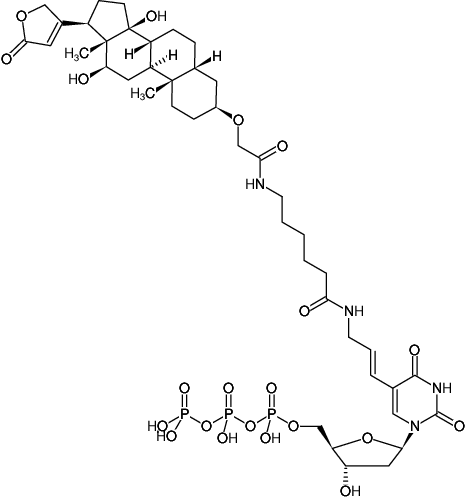Preparation of Digoxigenin-labeled DNA probes by PCR
| Cat. No. | Amount | Price (EUR) | Buy / Note |
|---|---|---|---|
| APP-101-DIGX-S | 35 reactions x 20 μl | 175,00 | Add to Basket/Quote Add to Notepad |
| APP-101-DIGX-L | 175 reactions x 20 μl | 425,00 | Add to Basket/Quote Add to Notepad |

For general laboratory use.
Shipping: shipped on gel packs
Storage Conditions: store at -20 °C
avoid freeze/thaw cycles
Shelf Life: 12 months
Description:
HighFidelity Digoxigenin PCR Labeling Kit is designed to produce randomly Digoxigenin-modified DNA probes by PCR. Such probes are ideally suited for in situ hybridization and Northern Blot experiments. PCR-based labeling is superior to random-primed labeling by Klenow fragment if template amounts are limited or amplification of a specific DNA fragments is required.
The labeling principle is similar to the underlying labeling principles of PCR DIG Labeling Mix (Roche) and PCR DIG Probe Synthesis Kit (Roche) with the exception that an alkali-stable version of DIG-11-dUTP is used (DIG label removal not feasible).
DIG-11-dUTP is efficiently incorporated into DNA as substitute for its natural counterpart dTTP using an optimized reaction buffer and a High Fidelity Polymerase. 35 % DIG-11-dUTP substitution typically results in an optimal balance between reaction and labeling efficiency. Individual optimization of DIG-11-dUTP/dTTP ratio however, can easily be achieved with the single nucleotide format. The resulting Digoxigenin-modified DNA probe can subsequently be detected by HRP- or AP-modified Digoxigenin antibody.
The kit contains sufficient reagents for 35 labeling reactions (S-Pack) or 175 labeling reactions (L-Pack) of 20 μl each (35 % DIG-11-dUTP substitution, 100 μM dATP/dGTP/dCTP, 65 μM dTTP, 35 μM DIG-11-dUTP).
Content:
High Fidelity Polymerase
in storage buffer with 50% glycerol (v/v)
#APP-101-DIGX-S: 1x 40 μl (100 units, 2.5 units/μl)
#APP-101-DIGX-L: 1x 200 μl (500 units, 2.5 units/μl)
High Fidelity Labeling Buffer
1x 500 μl (10x)
dATP - Solution
1x 20 μl (100 mM)
dGTP - Solution
1x 20 μl (100 mM)
dCTP - Solution
1x 20 μl (100 mM)
dTTP - Solution
1x 20 μl (100 mM)
DIG-11-dUTP
#APP-101-DIGX-S: 1x 25 μl (1 mM)
#APP-101-DIGX-L: 5x 25 μl (1 mM)
Lambda DNA
1x 20 μl (100 ng/μl)
500 bp forward primer
1x 20 μl (10 μM)
500 bp reverse primer
1x 20 μl (10 μM)
PCR-grade water
1x 1.2 ml
To be provided by user
DNA template
Primer
DNA purification tools (optional)
1. Preparation of working solutions
1.1 Preparation of 1 mM dATP/dCTP/dGTP working solution
1.2 Preparation of 1 mM dTTP working solution
3. Standard PCR Labeling protocol
The standard protocol is set-up for labeling of a 500 bp DNA fragment. An optimal balance between reaction and labeling efficiency is typically achieved with 35% DIG-11-dUTP substitution following the standard protocol below however, individual optimization might improve results for individual applications.
| Component | Volume | Final concenctration |
| PCR-grade water | X μl | |
| High Fidelity Buffer (10x) | 2 μl | 1x |
| 1 mM dATP/dCTP/ dGTP working solution (s. 1.1) | 2 μl | 100 μM |
| 1 mM dTTP working solution (s. 1.2) | 1.3 μl | 65 μM |
| 1 mM DIG-11-dUTP | 0.7 μl | 35 μM |
| forward primer (10 μM) | X μl | 0.1 - 1 μM (e.g. 0.3 μM 500 bp forward primer) |
| reverse primer (10 μM) | X μl | 0.1 - 1 μM (e.g. 0.3 μM 500 bp reverse primer) |
| template DNA | X μl | 1 - 10 ng genomic DNA (e.g. 1 ng Lambda DNA) |
| High Fidelity Pol (2.5 units/μl) | 1 μl | 2.5 units |
| Total volume | 20 μl |
Recommended cycling conditions
| Cycle step | Temperature | Time | Cycles |
| Initial denaturation | 95°C | 2 min | 1x |
| Denaturation Annealing1) Elongation2) | 95°C 58°C 68°C | 20 sec 30 sec 60 sec | 30x |
| Final Elongation | 68°C | 2 min | 1x |
For optimal amplification results and high incorporation rates an individual optimization of the recommended PCR assay and cycling conditions may be necessary for each new primer-template pair.
4. Probe purification:
Probe purification is not required for most hybridization experiments. If a downstream application requires purification (e.g. concentration determination by absorbance measurement) we recommend silica-membrane or gel filtration-based purification.
Related products: DIG-11-dUTP, #NU-803-DIGX
BIOZ Product Citations: